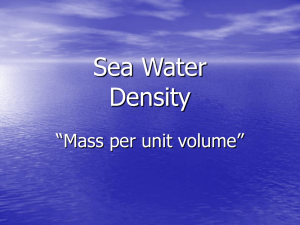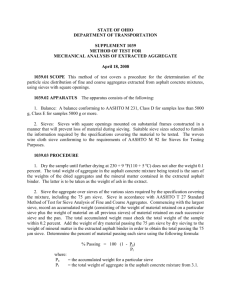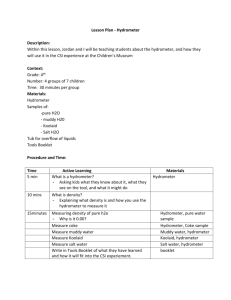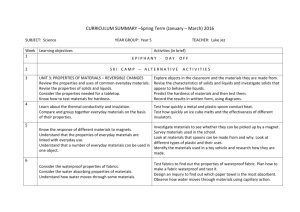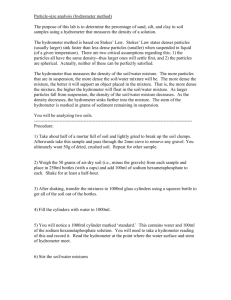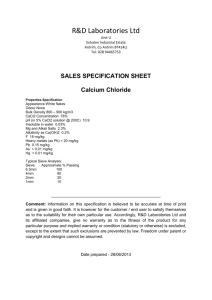Particle-Size Analysis of Soils1
advertisement
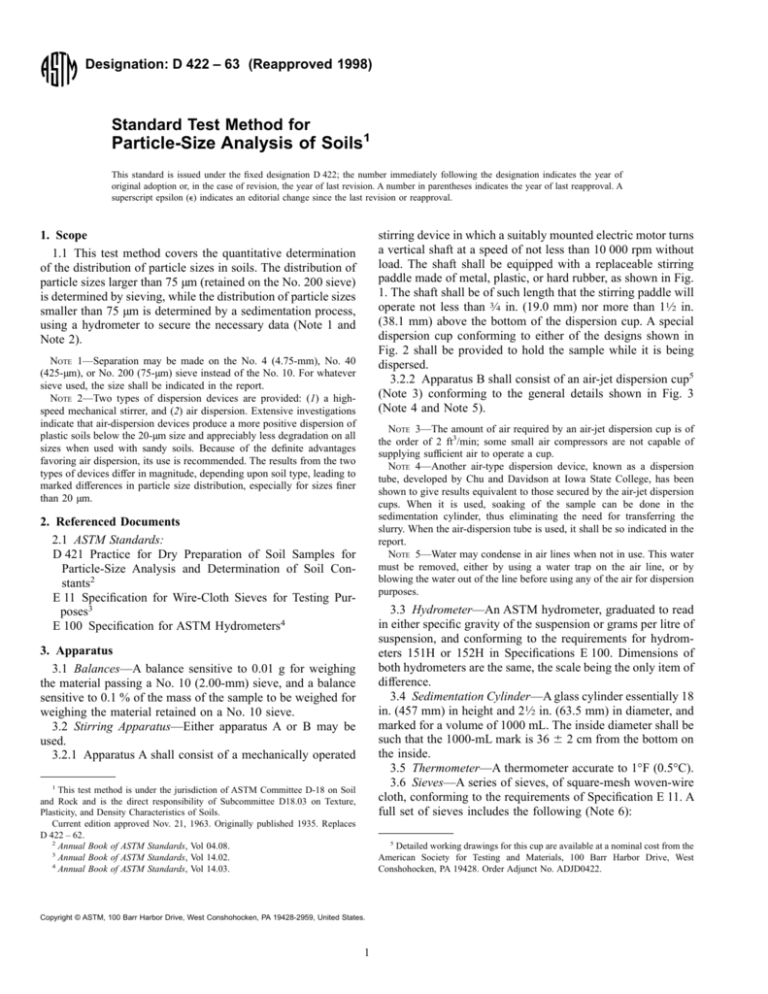
Designation: D 422 – 63 (Reapproved 1998) Standard Test Method for Particle-Size Analysis of Soils1 This standard is issued under the fixed designation D 422; the number immediately following the designation indicates the year of original adoption or, in the case of revision, the year of last revision. A number in parentheses indicates the year of last reapproval. A superscript epsilon (e) indicates an editorial change since the last revision or reapproval. stirring device in which a suitably mounted electric motor turns a vertical shaft at a speed of not less than 10 000 rpm without load. The shaft shall be equipped with a replaceable stirring paddle made of metal, plastic, or hard rubber, as shown in Fig. 1. The shaft shall be of such length that the stirring paddle will operate not less than 3⁄4 in. (19.0 mm) nor more than 11⁄2 in. (38.1 mm) above the bottom of the dispersion cup. A special dispersion cup conforming to either of the designs shown in Fig. 2 shall be provided to hold the sample while it is being dispersed. 3.2.2 Apparatus B shall consist of an air-jet dispersion cup5 (Note 3) conforming to the general details shown in Fig. 3 (Note 4 and Note 5). 1. Scope 1.1 This test method covers the quantitative determination of the distribution of particle sizes in soils. The distribution of particle sizes larger than 75 µm (retained on the No. 200 sieve) is determined by sieving, while the distribution of particle sizes smaller than 75 µm is determined by a sedimentation process, using a hydrometer to secure the necessary data (Note 1 and Note 2). NOTE 1—Separation may be made on the No. 4 (4.75-mm), No. 40 (425-µm), or No. 200 (75-µm) sieve instead of the No. 10. For whatever sieve used, the size shall be indicated in the report. NOTE 2—Two types of dispersion devices are provided: (1) a highspeed mechanical stirrer, and (2) air dispersion. Extensive investigations indicate that air-dispersion devices produce a more positive dispersion of plastic soils below the 20-µm size and appreciably less degradation on all sizes when used with sandy soils. Because of the definite advantages favoring air dispersion, its use is recommended. The results from the two types of devices differ in magnitude, depending upon soil type, leading to marked differences in particle size distribution, especially for sizes finer than 20 µm. NOTE 3—The amount of air required by an air-jet dispersion cup is of the order of 2 ft3/min; some small air compressors are not capable of supplying sufficient air to operate a cup. NOTE 4—Another air-type dispersion device, known as a dispersion tube, developed by Chu and Davidson at Iowa State College, has been shown to give results equivalent to those secured by the air-jet dispersion cups. When it is used, soaking of the sample can be done in the sedimentation cylinder, thus eliminating the need for transferring the slurry. When the air-dispersion tube is used, it shall be so indicated in the report. NOTE 5—Water may condense in air lines when not in use. This water must be removed, either by using a water trap on the air line, or by blowing the water out of the line before using any of the air for dispersion purposes. 2. Referenced Documents 2.1 ASTM Standards: D 421 Practice for Dry Preparation of Soil Samples for Particle-Size Analysis and Determination of Soil Constants2 E 11 Specification for Wire-Cloth Sieves for Testing Purposes3 E 100 Specification for ASTM Hydrometers4 3.3 Hydrometer—An ASTM hydrometer, graduated to read in either specific gravity of the suspension or grams per litre of suspension, and conforming to the requirements for hydrometers 151H or 152H in Specifications E 100. Dimensions of both hydrometers are the same, the scale being the only item of difference. 3.4 Sedimentation Cylinder—A glass cylinder essentially 18 in. (457 mm) in height and 21⁄2 in. (63.5 mm) in diameter, and marked for a volume of 1000 mL. The inside diameter shall be such that the 1000-mL mark is 36 6 2 cm from the bottom on the inside. 3.5 Thermometer—A thermometer accurate to 1°F (0.5°C). 3.6 Sieves—A series of sieves, of square-mesh woven-wire cloth, conforming to the requirements of Specification E 11. A full set of sieves includes the following (Note 6): 3. Apparatus 3.1 Balances—A balance sensitive to 0.01 g for weighing the material passing a No. 10 (2.00-mm) sieve, and a balance sensitive to 0.1 % of the mass of the sample to be weighed for weighing the material retained on a No. 10 sieve. 3.2 Stirring Apparatus—Either apparatus A or B may be used. 3.2.1 Apparatus A shall consist of a mechanically operated 1 This test method is under the jurisdiction of ASTM Committee D-18 on Soil and Rock and is the direct responsibility of Subcommittee D18.03 on Texture, Plasticity, and Density Characteristics of Soils. Current edition approved Nov. 21, 1963. Originally published 1935. Replaces D 422 – 62. 2 Annual Book of ASTM Standards, Vol 04.08. 3 Annual Book of ASTM Standards, Vol 14.02. 4 Annual Book of ASTM Standards, Vol 14.03. 5 Detailed working drawings for this cup are available at a nominal cost from the American Society for Testing and Materials, 100 Barr Harbor Drive, West Conshohocken, PA 19428. Order Adjunct No. ADJD0422. Copyright © ASTM, 100 Barr Harbor Drive, West Conshohocken, PA 19428-2959, United States. 1 D 422 Metric Equivalents in. mm 0.001 0.03 0.049 1.24 0.203 5.16 1⁄2 12.7 3⁄4 19.0 FIG. 1 Detail of Stirring Paddles 3.7 Water Bath or Constant-Temperature Room—A water bath or constant-temperature room for maintaining the soil suspension at a constant temperature during the hydrometer analysis. A satisfactory water tank is an insulated tank that maintains the temperature of the suspension at a convenient constant temperature at or near 68°F (20°C). Such a device is illustrated in Fig. 4. In cases where the work is performed in a room at an automatically controlled constant temperature, the water bath is not necessary. 3.8 Beaker—A beaker of 250-mL capacity. 3.9 Timing Device—A watch or clock with a second hand. 4. Dispersing Agent 4.1 A solution of sodium hexametaphosphate (sometimes called sodium metaphosphate) shall be used in distilled or demineralized water, at the rate of 40 g of sodium hexametaphosphate/litre of solution (Note 7). NOTE 7—Solutions of this salt, if acidic, slowly revert or hydrolyze back to the orthophosphate form with a resultant decrease in dispersive action. Solutions should be prepared frequently (at least once a month) or adjusted to pH of 8 or 9 by means of sodium carbonate. Bottles containing solutions should have the date of preparation marked on them. Metric Equivalents in. mm 1.3 33 2.6 66 3.75 95.2 4.2 All water used shall be either distilled or demineralized water. The water for a hydrometer test shall be brought to the temperature that is expected to prevail during the hydrometer test. For example, if the sedimentation cylinder is to be placed in the water bath, the distilled or demineralized water to be used shall be brought to the temperature of the controlled water bath; or, if the sedimentation cylinder is used in a room with controlled temperature, the water for the test shall be at the temperature of the room. The basic temperature for the hydrometer test is 68°F (20°C). Small variations of temperature do not introduce differences that are of practical significance and do not prevent the use of corrections derived as prescribed. FIG. 2 Dispersion Cups of Apparatus 3-in. (75-mm) 2-in. (50-mm) 11⁄2-in. (37.5-mm) 1-in. (25.0-mm) 3⁄4-in. (19.0-mm) 3⁄8-in. (9.5-mm) No. 4 (4.75-mm) No. No. No. No. No. No. 10 (2.00-mm) 20 (850-µm) 40 (425-µm) 60 (250-µm) 140 (106-µm) 200 (75-µm) NOTE 6—A set of sieves giving uniform spacing of points for the graph, as required in Section 17, may be used if desired. This set consists of the following sieves: 3-in. (75-mm) 11⁄2-in. (37.5-mm) 3⁄4-in. (19.0-mm) 3⁄8-in. (9.5-mm) No. 4 (4.75-mm) No. 8 (2.36-mm) No. No. No. No. No. 16 (1.18-mm) 30 (600-µm) 50 (300-µm) 100 (150-µm) 200 (75-µm) 5. Test Sample 5.1 Prepare the test sample for mechanical analysis as outlined in Practice D 421. During the preparation procedure 2 D 422 FIG. 3 Air-Jet Dispersion Cups of Apparatus B Metric Equivalents in. mm ⁄ 22.2 78 1 25.4 3 76.2 61⁄4 158.2 14 356 37 940 FIG. 4 Insulated Water Bath 5.2 Provision is made in Section 5 of Practice D 421 for weighing of the air-dry soil selected for purpose of tests, the separation of the soil on the No. 10 sieve by dry-sieving and washing, and the weighing of the washed and dried fraction retained on the No. 10 sieve. From these two masses the percentages retained and passing the No. 10 sieve can be calculated in accordance with 12.1. the sample is divided into two portions. One portion contains only particles retained on the No. 10 (2.00-mm) sieve while the other portion contains only particles passing the No. 10 sieve. The mass of air-dried soil selected for purpose of tests, as prescribed in Practice D 421, shall be sufficient to yield quantities for mechanical analysis as follows: 5.1.1 The size of the portion retained on the No. 10 sieve shall depend on the maximum size of particle, according to the following schedule: Nominal Diameter of Largest Particles, in. (mm) 3⁄8 (9.5) 3⁄4 (19.0) 1 (25.4) 11⁄2 (38.1) 2 (50.8) 3 (76.2) NOTE 8—A check on the mass values and the thoroughness of pulverization of the clods may be secured by weighing the portion passing the No. 10 sieve and adding this value to the mass of the washed and oven-dried portion retained on the No. 10 sieve. Approximate Minimum Mass of Portion, g 500 1000 2000 3000 4000 5000 SIEVE ANALYSIS OF PORTION RETAINED ON NO. 10 (2.00-mm) SIEVE 6. Procedure 5.1.2 The size of the portion passing the No. 10 sieve shall be approximately 115 g for sandy soils and approximately 65 g for silt and clay soils. 6.1 Separate the portion retained on the No. 10 (2.00-mm) sieve into a series of fractions using the 3-in. (75-mm), 2-in. 3 D 422 (50-mm), 11⁄2-in. (37.5-mm), 1-in. (25.0-mm), 3⁄4-in. (19.0mm), 3⁄8-in. (9.5-mm), No. 4 (4.75-mm), and No. 10 sieves, or as many as may be needed depending on the sample, or upon the specifications for the material under test. 6.2 Conduct the sieving operation by means of a lateral and vertical motion of the sieve, accompanied by a jarring action in order to keep the sample moving continuously over the surface of the sieve. In no case turn or manipulate fragments in the sample through the sieve by hand. Continue sieving until not more than 1 mass % of the residue on a sieve passes that sieve during 1 min of sieving. When mechanical sieving is used, test the thoroughness of sieving by using the hand method of sieving as described above. 6.3 Determine the mass of each fraction on a balance conforming to the requirements of 3.1. At the end of weighing, the sum of the masses retained on all the sieves used should equal closely the original mass of the quantity sieved. formed on the stem. For hydrometer 151H the composite correction is the difference between this reading and one; for hydrometer 152H it is the difference between the reading and zero. Bring the liquid and the hydrometer to the other temperature to be used, and secure the composite correction as before. 8. Hygroscopic Moisture 8.1 When the sample is weighed for the hydrometer test, weigh out an auxiliary portion of from 10 to 15 g in a small metal or glass container, dry the sample to a constant mass in an oven at 230 6 9°F (110 6 5°C), and weigh again. Record the masses. 9. Dispersion of Soil Sample 9.1 When the soil is mostly of the clay and silt sizes, weigh out a sample of air-dry soil of approximately 50 g. When the soil is mostly sand the sample should be approximately 100 g. 9.2 Place the sample in the 250-mL beaker and cover with 125 mL of sodium hexametaphosphate solution (40 g/L). Stir until the soil is thoroughly wetted. Allow to soak for at least 16 h. 9.3 At the end of the soaking period, disperse the sample further, using either stirring apparatus A or B. If stirring apparatus A is used, transfer the soil-water slurry from the beaker into the special dispersion cup shown in Fig. 2, washing any residue from the beaker into the cup with distilled or demineralized water (Note 9). Add distilled or demineralized water, if necessary, so that the cup is more than half full. Stir for a period of 1 min. HYDROMETER AND SIEVE ANALYSIS OF PORTION PASSING THE NO. 10 (2.00-mm) SIEVE 7. Determination of Composite Correction for Hydrometer Reading 7.1 Equations for percentages of soil remaining in suspension, as given in 14.3, are based on the use of distilled or demineralized water. A dispersing agent is used in the water, however, and the specific gravity of the resulting liquid is appreciably greater than that of distilled or demineralized water. 7.1.1 Both soil hydrometers are calibrated at 68°F (20°C), and variations in temperature from this standard temperature produce inaccuracies in the actual hydrometer readings. The amount of the inaccuracy increases as the variation from the standard temperature increases. 7.1.2 Hydrometers are graduated by the manufacturer to be read at the bottom of the meniscus formed by the liquid on the stem. Since it is not possible to secure readings of soil suspensions at the bottom of the meniscus, readings must be taken at the top and a correction applied. 7.1.3 The net amount of the corrections for the three items enumerated is designated as the composite correction, and may be determined experimentally. 7.2 For convenience, a graph or table of composite corrections for a series of 1° temperature differences for the range of expected test temperatures may be prepared and used as needed. Measurement of the composite corrections may be made at two temperatures spanning the range of expected test temperatures, and corrections for the intermediate temperatures calculated assuming a straight-line relationship between the two observed values. 7.3 Prepare 1000 mL of liquid composed of distilled or demineralized water and dispersing agent in the same proportion as will prevail in the sedimentation (hydrometer) test. Place the liquid in a sedimentation cylinder and the cylinder in the constant-temperature water bath, set for one of the two temperatures to be used. When the temperature of the liquid becomes constant, insert the hydrometer, and, after a short interval to permit the hydrometer to come to the temperature of the liquid, read the hydrometer at the top of the meniscus NOTE 9—A large size syringe is a convenient device for handling the water in the washing operation. Other devices include the wash-water bottle and a hose with nozzle connected to a pressurized distilled water tank. 9.4 If stirring apparatus B (Fig. 3) is used, remove the cover cap and connect the cup to a compressed air supply by means of a rubber hose. A air gage must be on the line between the cup and the control valve. Open the control valve so that the gage indicates 1 psi (7 kPa) pressure (Note 10). Transfer the soil-water slurry from the beaker to the air-jet dispersion cup by washing with distilled or demineralized water. Add distilled or demineralized water, if necessary, so that the total volume in the cup is 250 mL, but no more. NOTE 10—The initial air pressure of 1 psi is required to prevent the soil-water mixture from entering the air-jet chamber when the mixture is transferred to the dispersion cup. 9.5 Place the cover cap on the cup and open the air control valve until the gage pressure is 20 psi (140 kPa). Disperse the soil according to the following schedule: Plasticity Index Dispersion Period, min Under 5 6 to 20 Over 20 5 10 15 Soils containing large percentages of mica need be dispersed for only 1 min. After the dispersion period, reduce the gage pressure to 1 psi preparatory to transfer of soil-water slurry to the sedimentation cylinder. 4 D 422 12.3 To determine the total percentage passing for each sieve, divide the total mass passing (see 12.2) by the total mass of sample and multiply the result by 100. 10. Hydrometer Test 10.1 Immediately after dispersion, transfer the soil-water slurry to the glass sedimentation cylinder, and add distilled or demineralized water until the total volume is 1000 mL. 10.2 Using the palm of the hand over the open end of the cylinder (or a rubber stopper in the open end), turn the cylinder upside down and back for a period of 1 min to complete the agitation of the slurry (Note 11). At the end of 1 min set the cylinder in a convenient location and take hydrometer readings at the following intervals of time (measured from the beginning of sedimentation), or as many as may be needed, depending on the sample or the specification for the material under test: 2, 5, 15, 30, 60, 250, and 1440 min. If the controlled water bath is used, the sedimentation cylinder should be placed in the bath between the 2- and 5-min readings. 13. Hygroscopic Moisture Correction Factor 13.1 The hydroscopic moisture correction factor is the ratio between the mass of the oven-dried sample and the air-dry mass before drying. It is a number less than one, except when there is no hygroscopic moisture. 14. Percentages of Soil in Suspension 14.1 Calculate the oven-dry mass of soil used in the hydrometer analysis by multiplying the air-dry mass by the hygroscopic moisture correction factor. 14.2 Calculate the mass of a total sample represented by the mass of soil used in the hydrometer test, by dividing the oven-dry mass used by the percentage passing the No. 10 (2.00-mm) sieve, and multiplying the result by 100. This value is the weight W in the equation for percentage remaining in suspension. 14.3 The percentage of soil remaining in suspension at the level at which the hydrometer is measuring the density of the suspension may be calculated as follows (Note 13): For hydrometer 151H: NOTE 11—The number of turns during this minute should be approximately 60, counting the turn upside down and back as two turns. Any soil remaining in the bottom of the cylinder during the first few turns should be loosened by vigorous shaking of the cylinder while it is in the inverted position. 10.3 When it is desired to take a hydrometer reading, carefully insert the hydrometer about 20 to 25 s before the reading is due to approximately the depth it will have when the reading is taken. As soon as the reading is taken, carefully remove the hydrometer and place it with a spinning motion in a graduate of clean distilled or demineralized water. P 5 @~100 000/W! [m|]P5 G/~G 2 G 1!#~R 2 G1! (1) NOTE 13—The bracketed portion of the equation for hydrometer 151H is constant for a series of readings and may be calculated first and then multiplied by the portion in the parentheses. NOTE 12—It is important to remove the hydrometer immediately after each reading. Readings shall be taken at the top of the meniscus formed by the suspension around the stem, since it is not possible to secure readings at the bottom of the meniscus. For hydrometer 152H: P 5 ~Ra/W! [m|]P5 100 10.4 After each reading, take the temperature of the suspension by inserting the thermometer into the suspension. (2) where: a = correction faction to be applied to the reading of hydrometer 152H. (Values shown on the scale are computed using a specific gravity of 2.65. Correction factors are given in Table 1), P = percentage of soil remaining in suspension at the level at which the hydrometer measures the density of the suspension, R = hydrometer reading with composite correction applied (Section 7), W = oven-dry mass of soil in a total test sample represented by mass of soil dispersed (see 14.2), g, G = specific gravity of the soil particles, and G1 = specific gravity of the liquid in which soil particles are suspended. Use numerical value of one in both instances in the equation. In the first instance any possible variation produces no significant effect, and in the second instance, the composite correction for R is based on a value of one for G1. 11. Sieve Analysis 11.1 After taking the final hydrometer reading, transfer the suspension to a No. 200 (75-µm) sieve and wash with tap water until the wash water is clear. Transfer the material on the No. 200 sieve to a suitable container, dry in an oven at 230 6 9°F (110 6 5°C) and make a sieve analysis of the portion retained, using as many sieves as desired, or required for the material, or upon the specification of the material under test. CALCULATIONS AND REPORT 12. Sieve Analysis Values for the Portion Coarser than the No. 10 (2.00-mm) Sieve 12.1 Calculate the percentage passing the No. 10 sieve by dividing the mass passing the No. 10 sieve by the mass of soil originally split on the No. 10 sieve, and multiplying the result by 100. To obtain the mass passing the No. 10 sieve, subtract the mass retained on the No. 10 sieve from the original mass. 12.2 To secure the total mass of soil passing the No. 4 (4.75-mm) sieve, add to the mass of the material passing the No. 10 sieve the mass of the fraction passing the No. 4 sieve and retained on the No. 10 sieve. To secure the total mass of soil passing the 3⁄8-in. (9.5-mm) sieve, add to the total mass of soil passing the No. 4 sieve, the mass of the fraction passing the 3⁄8-in. sieve and retained on the No. 4 sieve. For the remaining sieves, continue the calculations in the same manner. 15. Diameter of Soil Particles 15.1 The diameter of a particle corresponding to the percentage indicated by a given hydrometer reading shall be calculated according to Stokes’ law (Note 14), on the basis that a particle of this diameter was at the surface of the suspension at the beginning of sedimentation and had settled to the level at 5 D 422 TABLE 1 Values of Correction Factor, a, for Different Specific Gravities of Soil ParticlesA Specific Gravity Correction FactorA 2.95 2.90 2.85 2.80 2.75 2.70 2.65 2.60 2.55 2.50 2.45 0.94 0.95 0.96 0.97 0.98 0.99 1.00 1.01 1.02 1.03 1.05 TABLE 2 Values of Effective Depth Based on Hydrometer and Sedimentation Cylinder of Specified SizesA Hydrometer 151H 1.000 1.001 1.002 1.003 1.004 1.005 1.006 1.007 1.008 1.009 1.010 1.011 1.012 1.013 1.014 1.015 1.016 1.017 1.018 1.019 1.020 1.021 1.022 1.023 1.024 1.025 1.026 1.027 1.028 1.029 1.030 1.031 1.032 1.033 1.034 1.035 1.036 1.037 1.038 A For use in equation for percentage of soil remaining in suspension when using Hydrometer 152H. which the hydrometer is measuring the density of the suspension. According to Stokes’ law: see Table 2 D 5 =@30n/980~G 2 G 1!# [m|]P5 L/T (3) where: D = diameter of particle, mm, n = coefficient of viscosity of the suspending medium (in this case water) in poises (varies with changes in temperature of the suspending medium), L = distance from the surface of the suspension to the level at which the density of the suspension is being measured, cm. (For a given hydrometer and sedimentation cylinder, values vary according to the hydrometer readings. This distance is known as effective depth (see Table 2)), T = interval of time from beginning of sedimentation to the taking of the reading, min, G = specific gravity of soil particles, and G1 = specific gravity (relative density) of suspending medium (value may be used as 1.000 for all practical purposes). NOTE 14—Since Stokes’ law considers the terminal velocity of a single sphere falling in an infinity of liquid, the sizes calculated represent the diameter of spheres that would fall at the same rate as the soil particles. A 16.3 16.0 15.8 15.5 15.2 15.0 14.7 14.4 14.2 13.9 13.7 13.4 13.1 12.9 12.6 12.3 12.1 11.8 11.5 11.3 11.0 10.7 10.5 10.2 10.0 9.7 9.4 9.2 8.9 8.6 8.4 8.1 7.8 7.6 7.3 7.0 6.8 6.5 6.2 0 1 2 3 4 5 6 7 8 9 10 11 12 13 14 15 16 17 18 19 20 21 22 23 24 25 26 27 28 29 30 16.3 16.1 16.0 15.8 15.6 15.5 15.3 15.2 15.0 14.8 14.7 14.5 14.3 14.2 14.0 13.8 13.7 13.5 13.3 13.2 13.0 12.9 12.7 12.5 12.4 12.2 12.0 11.9 11.7 11.5 11.4 31 32 33 34 35 11.2 11.1 10.9 10.7 10.6 36 37 38 39 40 41 42 43 44 45 46 47 48 49 50 51 52 53 54 55 56 57 58 59 60 10.4 10.2 10.1 9.9 9.7 9.6 9.4 9.2 9.1 8.9 8.8 8.6 8.4 8.3 8.1 7.9 7.8 7.6 7.4 7.3 7.1 7.0 6.8 6.6 6.5 Values of effective depth are calculated from the equation: L 5 L1 1 1 / 2 @L2 2 ~VB/A!# (5) where: L = effective depth, cm, L1 = distance along the stem of the hydrometer from the top of the bulb to the mark for a hydrometer reading, cm, L 2 = overall length of the hydrometer bulb, cm, VB = volume of hydrometer bulb, cm3, and A = cross-sectional area of sedimentation cylinder, cm2 15.2 For convenience in calculations the above equation may be written as follows: see Table 3 D 5 K=L/T Hydrometer 152H Actual Actual Effective Actual Effective Effective Hydrometer Hydrometer Depth, L, Hydrometer Depth, L, cm Depth, L, cm cm Reading Reading Reading (4) where: K = constant depending on the temperature of the suspension and the specific gravity of the soil particles. Values of K for a range of temperatures and specific gravities are given in Table 3. The value of K does not change for a series of readings constituting a test, while values of L and T do vary. 15.3 Values of D may be computed with sufficient accuracy, using an ordinary 10-in. slide rule. Values used in calculating the values in Table 2 are as follows: For both hydrometers, 151H and 152H: L2 = 14.0 cm VB = 67.0 cm3 A = 27.8 cm2 For hydrometer 151H: L1 = 10.5 cm for a reading of 1.000 = 2.3 cm for a reading of 1.031 For hydrometer 152H: L1 = 10.5 cm for a reading of 0 g/litre = 2.3 cm for a reading of 50 g/litre NOTE 15—The value of L is divided by T using the A- and B-scales, the square root being indicated on the D-scale. Without ascertaining the value of the square root it may be multiplied by K, using either the C- or CI-scale. 16. Sieve Analysis Values for Portion Finer than No. 10 (2.00-mm) Sieve 16.1 Calculation of percentages passing the various sieves used in sieving the portion of the sample from the hydrometer test involves several steps. The first step is to calculate the mass of the fraction that would have been retained on the No. 10 6 D 422 TABLE 3 Values of K for Use in Equation for Computing Diameter of Particle in Hydrometer Analysis Specific Gravity of Soil Particles Temperature,° C 2.45 2.50 2.55 2.60 2.65 2.70 2.75 2.80 2.85 16 17 18 19 20 21 22 23 24 25 26 27 28 29 30 0.01510 0.01511 0.01492 0.01474 0.01456 0.01438 0.01421 0.01404 0.01388 0.01372 0.01357 0.01342 0.01327 0.01312 0.01298 0.01505 0.01486 0.01467 0.01449 0.01431 0.01414 0.01397 0.01381 0.01365 0.01349 0.01334 0.01319 0.01304 0.01290 0.01276 0.01481 0.01462 0.01443 0.01425 0.01408 0.01391 0.01374 0.01358 0.01342 0.01327 0.01312 0.01297 0.01283 0.01269 0.01256 0.01457 0.01439 0.01421 0.01403 0.01386 0.01369 0.01353 0.01337 0.01321 0.01306 0.01291 0.01277 0.01264 0.01249 0.01236 0.01435 0.01417 0.01399 0.01382 0.01365 0.01348 0.01332 0.01317 0.01301 0.01286 0.01272 0.01258 0.01244 0.01230 0.01217 0.01414 0.01396 0.01378 0.01361 0.01344 0.01328 0.01312 0.01297 0.01282 0.01267 0.01253 0.01239 0.01255 0.01212 0.01199 0.01394 0.01376 0.01359 0.01342 0.01325 0.01309 0.01294 0.01279 0.01264 0.01249 0.01235 0.01221 0.01208 0.01195 0.01182 0.01374 0.01356 0.01339 0.1323 0.01307 0.01291 0.01276 0.01261 0.01246 0.01232 0.01218 0.01204 0.01191 0.01178 0.01165 0.01356 0.01338 0.01321 0.01305 0.01289 0.01273 0.01258 0.01243 0.01229 0.01215 0.01201 0.01188 0.01175 0.01162 0.01149 sieve had it not been removed. This mass is equal to the total percentage retained on the No. 10 sieve (100 minus total percentage passing) times the mass of the total sample represented by the mass of soil used (as calculated in 14.2), and the result divided by 100. 16.2 Calculate next the total mass passing the No. 200 sieve. Add together the fractional masses retained on all the sieves, including the No. 10 sieve, and subtract this sum from the mass of the total sample (as calculated in 14.2). 16.3 Calculate next the total masses passing each of the other sieves, in a manner similar to that given in 12.2. 16.4 Calculate last the total percentages passing by dividing the total mass passing (as calculated in 16.3) by the total mass of sample (as calculated in 14.2), and multiply the result by 100. NOTE 16—This tabulation of graph represents the gradation of the sample tested. If particles larger than those contained in the sample were removed before testing, the report shall so state giving the amount and maximum size. 18.2 For materials tested for compliance with definite specifications, the fractions called for in such specifications shall be reported. The fractions smaller than the No. 10 sieve shall be read from the graph. 18.3 For materials for which compliance with definite specifications is not indicated and when the soil is composed almost entirely of particles passing the No. 4 (4.75-mm) sieve, the results read from the graph may be reported as follows: (1) Gravel, passing 3-in. and retained on No. 4 sieve (2) Sand, passing No. 4 sieve and retained on No. 200 sieve (a) Coarse sand, passing No. 4 sieve and retained on No. 10 sieve (b) Medium sand, passing No. 10 sieve and retained on No. 40 sieve (c) Fine sand, passing No. 40 sieve and retained on No. 200 sieve (3) Silt size, 0.074 to 0.005 mm (4) Clay size, smaller than 0.005 mm Colloids, smaller than 0.001 mm 17. Graph 17.1 When the hydrometer analysis is performed, a graph of the test results shall be made, plotting the diameters of the particles on a logarithmic scale as the abscissa and the percentages smaller than the corresponding diameters to an arithmetic scale as the ordinate. When the hydrometer analysis is not made on a portion of the soil, the preparation of the graph is optional, since values may be secured directly from tabulated data. ..... ..... ..... ..... ..... ..... ..... ..... 18.4 For materials for which compliance with definite specifications is not indicated and when the soil contains material retained on the No. 4 sieve sufficient to require a sieve analysis on that portion, the results may be reported as follows (Note 17): SIEVE ANALYSIS Percentage Passing Sieve Size 18. Report 18.1 The report shall include the following: 18.1.1 Maximum size of particles, 18.1.2 Percentage passing (or retained on) each sieve, which may be tabulated or presented by plotting on a graph (Note 16), 18.1.3 Description of sand and gravel particles: 18.1.3.1 Shape—rounded or angular, 18.1.3.2 Hardness—hard and durable, soft, or weathered and friable, 18.1.4 Specific gravity, if unusually high or low, 18.1.5 Any difficulty in dispersing the fraction passing the No. 10 (2.00-mm) sieve, indicating any change in type and amount of dispersing agent, and 18.1.6 The dispersion device used and the length of the dispersion period. 3-in. 2-in. 11⁄2-in. 1-in. 3⁄4-in. 3⁄8-in. No. 4 (4.75-mm) No. 10 (2.00-mm) No. 40 (425-µm) No. 200 (75-µm) ......... ......... ......... ......... ......... ......... ......... ......... ......... ......... HYDROMETER ANALYSIS 0.074 mm 0.005 mm 0.001 mm ......... ......... ......... NOTE 17—No. 8 (2.36-mm) and No. 50 (300-µm) sieves may be substituted for No. 10 and No. 40 sieves. 7 % % % % % % % % D 422 19. Keywords 19.1 grain-size; hydrometer analysis; hygroscopic moisture; particle-size; sieve analysis The American Society for Testing and Materials takes no position respecting the validity of any patent rights asserted in connection with any item mentioned in this standard. Users of this standard are expressly advised that determination of the validity of any such patent rights, and the risk of infringement of such rights, are entirely their own responsibility. This standard is subject to revision at any time by the responsible technical committee and must be reviewed every five years and if not revised, either reapproved or withdrawn. Your comments are invited either for revision of this standard or for additional standards and should be addressed to ASTM Headquarters. Your comments will receive careful consideration at a meeting of the responsible technical committee, which you may attend. If you feel that your comments have not received a fair hearing you should make your views known to the ASTM Committee on Standards, at the address shown below. This standard is copyrighted by ASTM, 100 Barr Harbor Drive, PO Box C700, West Conshohocken, PA 19428-2959, United States. Individual reprints (single or multiple copies) of this standard may be obtained by contacting ASTM at the above address or at 610-832-9585 (phone), 610-832-9555 (fax), or service@astm.org (e-mail); or through the ASTM website (www.astm.org). 8
